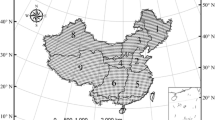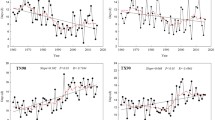Abstract
The variability of air temperature extremes exerts a great influence on agricultural production and the global hydrologic cycle. It has been the focus of attention for the past several decades. Using observed surface air temperature from 192 meteorological stations in South China maintained by the China Meteorological Administration, this study computed and analyzed 10 extreme temperature indices and the mean temperature at multiple spatiotemporal scales for the period from 1961 to 2018. These indices were analyzed with particular reference to the growing season of rice. Results showed that the variation trends of all annual indices exhibited different north–south patterns across decades, and the most recent 20-year period experienced greater warming than previous periods. The regional averaged rates of the annual mean maximum temperature, the annual mean minimum temperature, summer days, and tropical nights were 0.163 °C decade−1, 0.197 °C decade−1, 1.2 days decade−1, and 5.4 days decade−1, respectively. Except for the month of April, the southern region mostly experienced stronger warming than the northern region, especially in summer and autumn. Nighttime warming was usually greater than daytime warming, especially in June and October. Most temperature indices showed very weak correlations with large-scale atmospheric oscillations.







Similar content being viewed by others
Data availability
All the data are available in the public domain at the links provided in the texts.
Code availability
The codes used for the processing of data can be provided on request to the corresponding author.
References
Abera TA, Heiskanen J, Pellikka P, Maeda EE (2020) Impact of rainfall extremes on energy exchange and surface temperature anomalies across biomes in the Horn of Africa. Agric For Meteorol 280:107779
Brown SJ, Caesar J, Ferro CAT (2008) Global changes in extreme daily temperature since 1950. J Geophys Res 113:D05115
Chapman S, Watson JEM, Salazar A et al (2017) The impact of urbanization and climate change on urban temperatures: a systematic review. Landscape Ecol 32:1921–1935
Chen W, Zhu D, Huang C et al (2019) Negative extreme events in gross primary productivity and their drivers in China during the past three decades. Agric for Meteorol 275:47–58
Chen Y, Zhang L, Qian H (2016) Variation characteristics and spatial differences of extremely high temperature days over South China during the recent 53 Years. Trop Geogr 36(4):692–699
Diffenbaugh NS, Singh D, Mankin JS et al (2017) Quantifying the influence of global warming on unprecedented extreme climate events. Proc Natl Acad Sci 114(19):4881–4886
Easterling DR, Alexander LV, Mokssit A, Detemmerman V (2003) CCI/CLIVAR workshop to develop priority climate indices. Bull Am Meteor Soc 84(10):1403–1407
Eck MA, Murraya AR, Wardc AR et al (2020) Influence of growing season temperature and precipitation anomalies on crop yield in the southeastern United States. Agric For Meteorol 291:108053
Fischer T, Gemmer M, Liu L, Su B (2010) Trends in monthly temperature and precipitation extremes in the Zhujiang River Basin, South China (1961–2007). Adv Clim Chang Res 1(2):63–70
Fischer EM, Knutti R (2015) Anthropogenic contribution to global occurrence of heavy-precipitation and high-temperature extremes. Nat Clim Chang 5(6):560–564
Gao M, Franzke CL (2017) Quantile regression–based spatiotemporal analysis of extreme temperature change in China. J Clim 30(24):9897–9914
IPCC (2007) Climate change 2007: the physical science basis. Contribution of Working Group I to the Fourth Assessment Report of the Intergovernmental Panel on Climate Change. In: Solomon S, Qin D, Manning M, Chen Z, Marquis M, Averyt KB, Tignor M and Miller HL (Eds.). Cambridge University Press, Cambridge, United Kingdom and New York, NY, USA
KarimzadehSoureshjani H, GhorbaniDehkordi A, Bahador M (2019) Temperature effect on yield of winter and spring irrigated crops. Agric For Meteorol 279:107664
Li QX, Dong WJ, Li W et al (2010) Assessment of the uncertainties in temperature change in China during the last century. Chin Sci Bull 55(19):1974–1982
Lobell DB, Hammer GL, McLean G et al (2013) The critical role of extreme heat for maize production in the United States. Nat Clim Chang 3(5):497–501
Lobell DB, Schlenker W, Costa-Roberts J (2011) Climate trends and global crop production since 1980. Science 333(6042):616–620
Mann HB (1945) Nonparametric tests against trend. Econometrica J Econometric Soc 13:245–259
Moriondo M, Giannakopoulos C, Bindi M (2011) Climate change impact assessment: the role of climate extremes in crop yield simulation. Clim Change 104(3–4):679–701
Niu Z, Wang L, Fang L et al (2020) Analysis of spatiotemporal variability in temperature extremes in the Yellow and Yangtze River basins during 1961–2014 based on high-density gauge observations. Int J Climatol 40(1):1–21
Peng S, Huang J, Sheehy JE et al (2004) Rice yields decline with higher night temperature from global warming. Proc Natl Acad Sci 101(27):9971–9975
Peng S, Piao S, Ciais P et al (2013) Asymmetric effects of daytime and night-time warming on Northern Hemisphere vegetation. Nature 501:88–92
Piao S, Ciais P, Huang Y et al (2010) The impacts of climate change on water resources and agriculture in China. Nature 467(7311):43–51
Rosenzweig C, Elliott J, Deryng D et al (2014) Assessing agricultural risks of climate change in the 21st century in a global gridded crop model intercomparison. Proc Natl Acad Sci 111(9):3268–3273
Sen PK (1968) Estimates of the regression coefficient based on Kendall’s tau. J Am Stat Assoc 63(324):1379–1389
Shi J, Cui L, Ma Y et al (2018) Trends in temperature extremes and their association with circulation patterns in China during 1961–2015. Atmos Res 212:259–272
Shi PJ, Sun S, Wang M et al (2014) Climate change regionalization in China (1961–2010). Sci China Earth Sci 57(11):2676–2689
Sun W, Huang Y (2011) Global warming over the period 1961–2008 did not increase high-temperature stress but did reduce low-temperature stress in irrigated rice across China. Agric for Meteorol 151(9):1193–1201
Sun Y, Zhang XB, Ren GY et al (2016) Contribution of urbanization to warming in China. Nat Clim Chang 6:706–709
Sun Y, Zhang XB, Zwiers FW et al (2014) Rapid increase in the risk of extreme summer heat in Eastern China. Nat Clim Chang 4(12):1082–1085
Tong S, Li X, Zhang J et al (2019) Spatial and temporal variability in extreme temperature and precipitation events in Inner Mongolia (China) during 1960–2017. Sci Total Environ 649:75–89
Wei K, Chen W (2009) Climatology and trend of high temperature extremes across China in summer. Atmos Oceanic Sci Lett 2(3):153–158
Wu CH, Huang GR (2016) Projection of climate extremes in the Zhujiang River basin using a regional climate. Int J Climatol 36:1184–1196
Wu X, Hao Z, Hao F, Zhang X (2019) Variations of compound precipitation and temperature extremes in China during 1961–2014. Sci Total Environ 663:731–737
Yu ZW, Yao YW, Yang GY et al (2019) Spatiotemporal patterns and characteristics of remotely sensed region heat islands during the rapid urbanization (1995–2015) of southern China. Sci Total Environ 674:242–254
Zhang Q, Li JF, Chen YD, Chen X (2011) Observed changes of temperature extremes during 1960–2005 in China: natural or human-induced variations? Theoret Appl Climatol 106(3–4):417–431
Zhang Q, Li JF, Singh VP, Xiao M (2013) Spatio-temporal relations between temperature and precipitation regimes: implications for temperature-induced changes in the hydrological cycle. Glob Planet Chang 111:57–76
Zhang S, Tao FL, Zhang Z (2016) Changes in extreme temperatures and their impacts on rice yields in southern China from 1981 to 2009. Field Crop Res 189:43–50
Zhang W, Jin FF, Turner A (2014) Increasing autumn drought over southern China associated with ENSO regime shift. Geophys Res Lett 41(11):4020–4026
Zhao N, Jiao Y, Ma T et al (2019) Estimating the effect of urbanization on extreme climate events in the Beijing-Tianjin-Hebei region, China. Sci Total Environ 688:1005–1015
Zhao XL, Zhang ZX, Wang X et al (2014) Analysis of Chinese cultivated land’s spatial temporal changes and causes in recent 30 years. Trans Chin Soc Agric Eng 30(3):1–11 (In Chinese)
Acknowledgements
We would like to thank the China Meteorological Administration (CMA) for providing the meteorological data.
Funding
This work was supported by the National Natural Science Foundation of China (grant number 42005142, 41605118) and the Key Science and Technology Planning Project of Guangdong Province (grant number 2019B020214003).
Author information
Authors and Affiliations
Contributions
Leidi Wang and Fei Hu analyzed the data and wrote the paper. Jing Hu and Chen Chen assisted in data processing and analysis and interpreted the results. Xian Liu and Dingling Zhang assisted in drawing and writing the original draft. Tingting Chen and Yuchen Miao participated in data curation and validation. Lei Zhang designed the study and participated in writing-editing.
Corresponding author
Ethics declarations
Ethics approval
The authors confirm that this article is original research and has not been published or presented previously in any journal or conference in any language.
Consent to participate
Not applicable.
Consent for publication
All the authors consented to publish the paper.
Conflict of interest
The authors declare no competing interests.
Additional information
Publisher's note
Springer Nature remains neutral with regard to jurisdictional claims in published maps and institutional affiliations.
Supplementary Information
Below is the link to the electronic supplementary material.
Rights and permissions
About this article
Cite this article
Wang, L., Hu, F., Hu, J. et al. Multistage spatiotemporal variability of temperature extremes over South China from 1961 to 2018. Theor Appl Climatol 146, 243–256 (2021). https://doi.org/10.1007/s00704-021-03728-4
Received:
Accepted:
Published:
Issue Date:
DOI: https://doi.org/10.1007/s00704-021-03728-4




